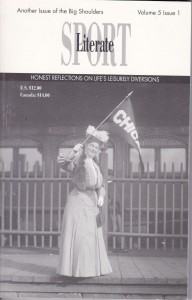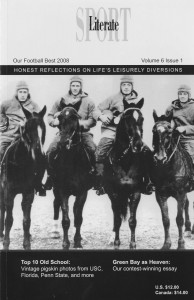Q&A with Rus Bradburd
by Nicholas Reading
Recruiting Shawn Harrington to New Mexico State from Marshall High School in Chicago, Rus Bradburd described him as an “exceedingly smart, unselfish, and fearless” basketball player. Then an assistant coach, Bradburd was known for bringing Chicago players to the southwest. A decade prior, he lured the future NBA great Tim Hardaway to Texas at El Paso.
In 2014, when Harrington was back in Chicago coaching at Marshall, his unselfish fearlessness was on full display, as he covered his daughter’s body to protect her from drive-by bullets in a case of tragic mistaken identity. In saving his daughter’s life, Harrington was left paralyzed.
“Shawn’s shooting was all over the Chicago news. A coaching friend texted me about it within an hour of the incident, so I began tracking it on the internet,” says Bradburd, now a creative writing professor at New Mexico State. “Although I hadn’t seen Shawn in 20 years, I had spoken to him when his mother was killed in 2003, so I still had his phone number. I waited a week to call, but I thumbed through the New Mexico State basketball programs to rattle my memory of his time playing for us at New Mexico State — which is where things got complicated.”
That complication eventually led to the book, All the Dreams We’ve Dreamed: A Story  of Hoops and Handguns on Chicago’s West Side, which will be released on May 1, 2018.
of Hoops and Handguns on Chicago’s West Side, which will be released on May 1, 2018.
Nicholas Reading: Your book invites the reader into the lives of Shawn Harrington and the Chicago West Side community. The value of making folks, who might be otherwise unknown, into very real, very living people, is immeasurable. You write intimately and personally about their experiences. What do you hope this portrait contributes to the national discussion about guns, violence, and the state of our communities?
Rus Bradburd: I only wanted to tell Shawn Harrington’s story, and the story of the Marshall High School community. At the outset I had very strong opinions about guns, cops, education, and the situation on the West Side of Chicago, but whenever I tried to address the bigger issues — or pretend I had answers — the book started to spin out of control. So I kept the story smaller, which of course became tricky as more and more Marshall players got murdered.
NR: It is one thing to sympathize, even empathize, with someone who has experienced hardship. It’s quite another to initiate the task of writing a book and giving someone’s experience a wider audience. How did you arrive at the idea for this project?
RB: Initially I was only advocating for Shawn, writing to friends who were journalists: Hey! Here is an astonishing story of courage. I was going to sleep at night thinking of Shawn’s trouble, waking up and wondering how I might help. And the more he was ignored — and I was ignored — the more determined I was to keep banging on my drum. I have a daughter the same age as Shawn’s younger one, so the act of heroism in saving a girl’s life was profoundly moving. Finally, Alex Kotlowitz [bestselling author of There Are No Children Here] said to me, “Why don’t you write this yourself?”
NR: What is so striking about sports is that it is often a confluence of social, racial, economic, political concerns. If Shawn’s story and your writing is a lens through which to closely examine our society, what issues does your book bring into focus?
RB: I think people will read the book differently. As they should, I suppose. Basketball, more than any other sport, gives us a window into African American culture. Even in Chicago, though, you can go through your entire life and never really come in contact with what it’s like for millions of Americans on a day-to-day basis. My hope is that in the specifics of Shawn Harrington’s story that there might be a more universal feeling of empathy. Although I only wanted to tell his story, there are issues of health care, race, guns, unions, poverty, education, basketball, and community policing all swimming around in the book.
NR: What do you think are the most damaging or prevalent misconceptions about communities ravaged by gun violence?
RB: I think the Black Lives Matter stance is badly misunderstood at times. Here’s where it became real to me: nothing tears apart a community like an unsolved murder. In Chicago, there are far fewer murder detectives than there was a decade ago. That’s the institutionalized problem: shootings and killings are never brought to justice, and an unsolved murder encourages revenge. The closing of schools ruins neighborhoods, too. Marshall, when Shawn attended, had over 2,000 students. Today it’s below 400. Empty schools aren’t good for the community. Schools should be the center of the community.
NR: How did the team respond after Shawn was shot? What is their response when mounting numbers of teammates and friends are victims of gun violence? What does this response say about them? About their reality?
RB: One of the surprising things about writing the book is learning how everyone has a connection to the violence. This was mirrored for me in the 10 months I lived in Belfast: everyone had been touched by “The Troubles,” and people mostly didn’t want to talk about it. I was surprised that the players and coaches never talked about their own gun violence experiences, but maybe that’s just me: my impulse is to talk about something until I’m blue in the face. That’s something I learned from writing the Nolan Richardson biography, Forty Minutes of Hell: things don’t get better by not talking about them.
NR: The book opens with a quote from Langston Hughes that seems to both lament and hold dear a, “dream that’s almost dead today.” Obviously, an inspiration for the title of the book, but I wonder if you could explain how the poem speaks to you? What is the dream?
RB: To my ear, Langston Hughes has two voices speaking in the poem, and the refrain “America was never America to me” feels reflective of the West Side community of Chicago. I think if Shawn had saved a girl’s life in Iraq while on duty, he’d be on the cover of Time Magazine. Because it happened in Chicago, it’s just another shooting, and, in fact, a “good” story because he lived. In any other Westernized country, Shawn would have a far better safety net than in America.
NR: Sports are sometimes relegated to mere pastime, entertainment, and maybe exercise. Though, it seems that the role of basketball in the lives of the folks you present is far from just a hobby. In your view, how does the sport, the gym, offer not only a haven from the streets, but mentor-ship, a way of surviving?
RB: Basketball can be a blessing, but only 20 or 25 boys play at every Chicago Public School. And in some ways, for the ballers, the game can be a mirage or a time-killer. For so many, once basketball season is over senior year, there’s the stark reality: Now what? The game gave them discipline, teamwork, a goal. But what about when the game is over? And I think a more important question might be, “What about the other kids, the 90 percent who do not play?”
NR: What does Harrington say, what does the community say, what do you say about a hope for a solution to gun violence? You have brought to our attention, with intimacy and urgency, the faces and lives of people living in an America that many can’t fathom. You have called Harrington’s situation a “failure of America,” and I think the reader understands why. This question might be an unfair burden, but where do we go from here?
RB: I don’t know. One thing I stress is that there are great people who have dedicated their lives to ending the violence, so I’m modest about offering any solutions as the “new guy” who just arrived. While Shawn has remarkable courage and endurance, and so many of us find that inspiring, I think the big answers are complicated. Poverty, education, family, community policing, ending the drug wars — they’re all tied in, but again, I only really know Shawn’s story. Yet, there’s the “Zen Mind, Beginner’s Mind” idea that if you know one thing, you know the world. I guess I’m saying that I hope that reading about Shawn’s life might be a start — just as basketball was a window into a part of black culture for me, perhaps his story might a window into the West Side for others.
NR: What does Shawn envision for his family, the future of Marshall? For himself? And is his story unique?
RB: Shawn’s struggles are very much day-to-day. Get out of the house. Get his exercise. Go to therapy. Talk to Marshall kids and ex-players. That’s one of the great tensions in the book: I want him to be Jackie Robinson or Muhammad Ali, be the spokesman for progressive movements. He wants that stuff, sure, but it’s the daily grind that wears on him, I fear. The scariest part to me is that there are thousands — really, thousands — of young men in Chicago like Shawn who have been physically and emotionally torn apart by guns. There won’t be a book about many of the others, or not an in-depth study. But who will advocate for them?
NR: Writing about your relationship with Shawn you observe, “… our lives were intertwined. His success or failure would contribute to mine.” How has Shawn’s life changed your own?
RB: I believe that Shawn’s suffering and struggle stands for more — that it has enriched my life, as strange as that is to say. He’s both fully heroic and fully human. That’s part of the human psyche, sort of Joseph Campbell 101: The Hero makes things better for everyone else.
NR: Is there an experience or realization that you encountered over the course of writing this book that surprised you?
RB: Let me see if can answer that sideways. What I miss most about coaching in Division I basketball — where I spent 14 years and made 8 NCAA tournaments — is the total, free health care. No waiting, no charge, no hassles, you get to see the doctor right away. I’m fairly healthy, although not that young, so I don’t worry so much about health care. But seeing it up close, how you need a full-time advocate to battle the system — well, what kind of country is this?
NR: How does Shawn’s story, the story of gun violence in Chicago, and the story of hope fit into the national discussion on the subject?
RB: Dorothy Gaters, the legendary Marshall girls’ coach, says that Columbine, Sandy Hook, and Marjory Stoneman Douglass High School are not on the West Side. She’s right: it’s a national problem, and it’s uniquely American. The “line” is always drawn somewhere — I can’t own a bazooka or a tank or an ICMB, right? We just need to move the line. That’s happened so many times in American history, and it’s always a collective consciousness that changes. I hope Shawn’s life can be part of that conversation.
Nicholas Reading is the author of the chapbook The Party In Question (Burnside Review Press, 2007) and Love & Sundries (SplitLip Press, 2014). His poetry has appeared or is forthcoming in Bat City Review, jubilat, Nimrod, Painted Bride Quarterly, and San Pedro River Review. He serves as the poetry editor for Sport Literate and teaches a freshman seminar on sports and literature at Butler University.
Rus Bradburd spent 14 seasons as a college basketball coach at UTEP and New Mexico State, then two more in Irish Super League. He is the author of All the Dreams We’ve Dreamed (Chicago Review Press, 2018), an examination of gun violence in Chicago; the novel-in-stories Make It, Take It (Cinco Puntos Press, 2014); the controversial Forty Minutes of Hell (HarperCollins/Amistad Books, 2010); and the memoir Paddy on the Hardwood: A Journey in Irish Hoops (University of New Mexico Press, 2006). He lives in New Mexico and Chicago.



 A Meditation on the Almost-Superman, or Maybe Just on
A Meditation on the Almost-Superman, or Maybe Just on 




